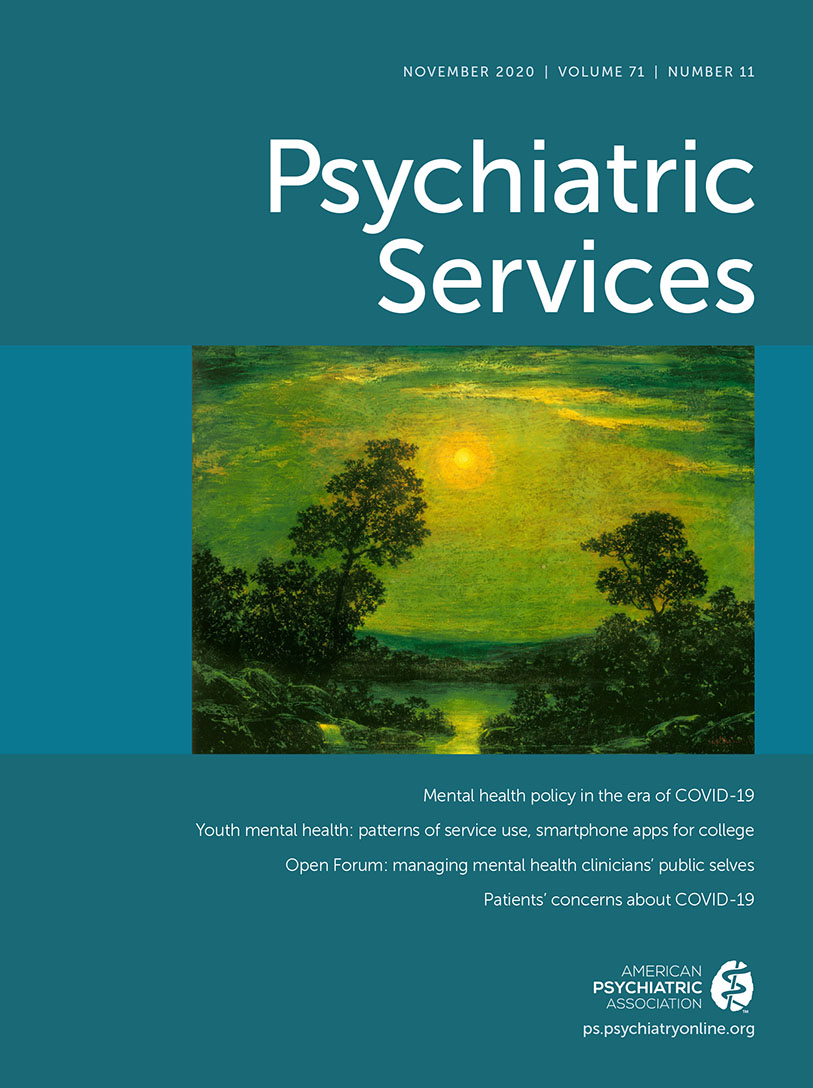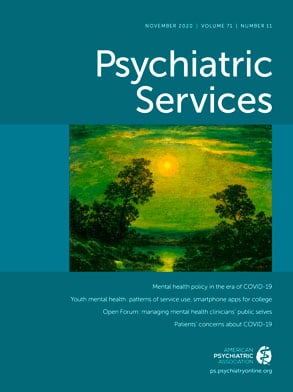Asian Americans are the fastest growing population in the United States. By 2050, the population of Asian Americans in the country will grow from 5.6% to 9.2% (
1). The image of the well-adjusted, successful “model minority” dismisses important mental health concerns and continues to hurt Asian Americans.
Research has increasingly documented the paradox that, despite high academic performance, young Asian American women die by suicide at an alarming rate. Among women between 20 and 24 years of age, Asian Americans were the only group that showed suicide as the leading cause of death. For their white and American Indian counterparts, suicide was the second leading cause of death (
2). Yet Asian American young adults have the lowest prevalence of mental health diagnosis (
3), prescribed medication, and treatment, with roughly 80% of cases untreated in educational and mental health settings (
4). Known as “hidden ideators,” Asian American women at high risk for suicide often suffer alone and underreport symptoms of suicide and depression; thus, identifying and intervening with Asian Americans at risk for suicide are complex yet essential tasks.
How can providers address the mental health concerns among young Asia American women? How can this be achieved in a culturally competent manner? To answer these questions, we recognize the salience of culture and identity and their impact throughout the personal development of Asian American women. These questions are best informed by socioecological theories, specifically, Bronfenbrenner’s theory of ecological systems (
5), minority stress theory (
6), and cognitive theory of stress and coping. In addition, through epidemiological studies on Asian American women’s mental health and health risk behaviors, we identified risk and protective factors for mental health among Asian American women and translated them into a treatment approach.
Asian Women’s Action for Resilience and Empowerment (AWARE) consists of 8 weeks of face-to-face group therapy sessions led by Asian American therapists. Integrating technology, AWARE also delivers a series of short, daily text messages called “AWARE stories” to ensure that women feel supported by and connected to the group and to reduce isolation. To our knowledge, AWARE is the only intervention specifically designed to address mental health problems in this population. A previous randomized controlled trial that studied Chinese, Korean, and Vietnamese American daughters of immigrants (1.5 and second generation), demonstrated safety, feasibility, and efficacy (
7). Although women from these diverse Asian cultures have many differences, we have noted particular experiences that are shared across these cultural groups.
The AWARE intervention is a culturally grounded approach, using a conceptual framework that explains why Asian American women frequently feel disempowered and trapped. The intervention incorporates gender- and culture-specific elements, such as methods for participants to enhance their understanding of their own identities and common gender roles, navigate the dynamics of living in an immigrant family, and cope with discrimination as Asian American women (
7).
Through developing and implementing the AWARE intervention, we identified four important culturally and developmentally informed intervention targets for mental health providers to address in their work with young Asian American women. These targets are encompassed in what Hahm et al. (
7) refer to as “the model of healing: dismantling disempowerment traps for Asian American women.” This model recognizes that Asian American women face culturally mediated mental health risk factors that might lead them to feel disempowered (“disempowerment traps”). These traps occur at four socioecological levels: individual, interpersonal, community, and system. The levels, their associated risk factors, and the interventions targeted to the risk factors are summarized in
Table 1 and described below.
Individual Level (“Inner Voice Trap”)
In the Asian cultural context, financial, career, and academic successes are often viewed as integral to identity, and problems in these life domains can generate feelings of shame, emotional distress, guilt, and inadequacy. The salience of these domains does not pertain exclusively to Asian Americans; however, these were identified as risk factors drawn from previous data on Asian American women. These feelings are disproportionately prevalent among young Asian American women who have the highest college graduation rates, in relation to women in all other racial-ethnic groups with the same education. We term this phenomenon the “inner voice trap.” This trap acts at the individual level to contribute to poor clinical outcomes. Ecological theory posits that individuals are prone to experience a decrease in distress tolerance when faced with stressors and inadequate coping resources (
8). Additionally, individuals trapped by this inner voice report engaging in unsafe coping mechanisms, such as use of alcohol or drugs to boost self-esteem or escape this trap (
9). In-depth interviews with Asian American women show the narratives of inner voice traps: “I strive for excellence. I feel really bad if I don’t meet the expectations.” “I am what I achieve. Without my achievement, I will become a failure.” “I am expected to be ‘perfect.’” This unachievable expectation affects mood, self-esteem, and aspiration.
Active components of AWARE are designed to specifically address this inner voice trap. Cognitive restructuring and problem-solving skills are implemented to reduce maladaptive perfectionism and replace unsafe coping mechanisms with safe and empowering coping strategies. Mindfulness (e.g., grounding and relaxation exercises) helps to promote acceptance of life domains and to increase distress tolerance—a potential mediator of improvement in behavioral and emotional symptoms.
Family Level (“Family Trap”)
Young Asian American women frequently experience disempowering parenting, a microsystem-level risk factor in the ecological model of mental health. In our previous work, we identified the links between a disempowering parenting style (ABCDG parenting), fractured identity, and self-harm/suicidal behaviors through an analysis of in-depth interviews of self-harming and suicidal young Asian American women. ABCDG parenting refers to abusive, burdening, culturally disjointed, disengaged, and gender-prescriptive parenting (
9) and is hypothesized to lead young Asian American women to constantly experience a “double bind” of competing identities and lack of self-agency—a “fractured identity.” Examples of “family trap” narratives include, “I am already working hard, but whatever I do, I will never be good enough for my mother”; “My family was really hard on me growing up in terms of…the picture-perfect demeanor I would have to maintain to compete with their friend’s children”; and “I used to feel very mediocre or not good enough that I considered very many times thoughts of suicide and even an attempt one time” (
10).
AWARE integrates strategies to specifically address these family-level traps. Psychoeducation on disempowering parenting style is provided, and therapists normalize and validate any invalidating experiences that took place within the family. AWARE seeks to develop a sense of agency and control by supporting the establishment of healthy boundaries with parents. This increase in agency and control is intended to reduce conflict within families (a potential mediator for targeted outcomes). Indeed, participants reported that discussion with family members on this topic increased their understanding of effective interpersonal coping strategies.
Community Level (“Race Trap”)
Ongoing experiences of prejudice and racial discrimination adversely affect physical and mental health for those belonging to minority groups (
5,
6). For young Asian American women, race-related stressors commonly take the form of hostile and noninclusive social environments, challenges in gaining acceptance within groups or institutions, and the “bamboo ceiling” (non-merit-based barriers that exclude Asian Americans from leadership positions). Examples of “race trap” narratives are, “At school, I constantly feel that I am an invisible minority”; “I want to be proud of being a Chinese American, but I am feeling ashamed about being Chinese because of how China and Chinese people are being portrayed in the media”; and “Because I am Asian, they automatically think that I am good at math but bad at sports and they think that I am good at math only because I am Asian. But actually, I have to work very hard to be good at what I am good at!”
AWARE specifically promotes coping with these community-level traps. Through its group format, AWARE provides a safe forum to discuss Asian American identity, bicultural minority stress, microaggressions, and microinvalidation. The group generates support and reduces isolation. Participants resolve personal identity conflicts, leading them to feel a sense of empowerment, strength, and renewed commitment to their lives with a drive for self-advocacy.
System Level (“Suffering-Alone Trap”)
At the macrosystem level, Asian American norms against seeking help contribute significantly to poor mental health outcomes among young Asian American women (
4). AWARE provides socially and culturally specific mental health content through AWARE stories. Narratives of the “suffering-alone trap” include, “[When I get depressed, I] just do nothing. Just don’t say anything and it will usually work out”; and “I personally didn’t like the mode of [individual] therapy that was available at the time. It’s like a lot of talk therapy, which—I’m kind of a do-it-yourselfer” (
4).
AWARE targets these culturally contextualized mental health risk factors at all four levels through both its format and its content. By focusing on strengthening therapeutic alliance and destigmatizing mental health service use, AWARE helps participants overcome the culture of silence both in the home and in the broader community. AWARE also uses Asian American therapists, because gender and racial match of therapists and clients was found to be more important for Asian American women than for Asian American men, white American women, and white American men.
Many participants reported that having an Asian American therapist was an essential determinant of their engagement. These therapists were viewed as “sociocultural experts,” who were more trustworthy and emotionally accessible than were non–Asian American female therapists. Participants reported that Asian American therapists are particularly valued because their depth of understanding, shared experiences, and relatability are stronger than are those of non–Asian American therapists. Although participants would typically feel that non–Asian American therapists sympathized with them, they felt more “understood” by their Asian American counterparts. The trust, sense of safety, and comfort were strong enough for participants to share taboo or shameful experiences.
Conclusions
The high rates of mental health problems and their undertreatment among Asian American women are concerning. The principles underlying our AWARE intervention can facilitate the work of other mental health professionals to address the mental health concerns of Asian American women in a culturally competent manner. While originally developed and tested among Chinese, Korean, and Vietnamese American women, AWARE has since been expanded to encompass a more diverse range of Asian American ethnic backgrounds. These women also reported that the intervention strongly resonated with their own experiences, suggesting the potential utility of AWARE for diverse Asian American women.
A specific strategy of our AWARE intervention has been to help young women recognize common traps that lead to disempowerment and develop strategies to overcome them. These traps may not be exclusive to young Asian American women. Many young, ambitious women may find themselves caught in some of these traps. However, important Asian cultural frameworks enhance the likelihood that Asian American women will find themselves trapped in this web of risk factors (e.g., rigid ideas for determining success, disempowering parenting, experience of racism or prejudice from society). Thus, although these risks are not exclusive to Asian American women, their combination appears particularly salient for this population.
The AWARE intervention has taken place in college campus and high school settings through a group psychotherapy format. However, the identified traps can be generalized to providers outside of university contexts, including those who work with patients or clients in hospital, community, or private practice settings. The introduction of these four traps may provide the language to define potential core therapeutic approaches related to disempowering traps. Such approaches include cognitive restructuring, being attuned to emotional experiences or situations that are associated with disempowerment, and the development of alternative coping skills. We hope that this framework will provide a lens that facilitates the cognitive-behavioral therapy and mindfulness treatment used by mental health professionals working with young Asian American women.

